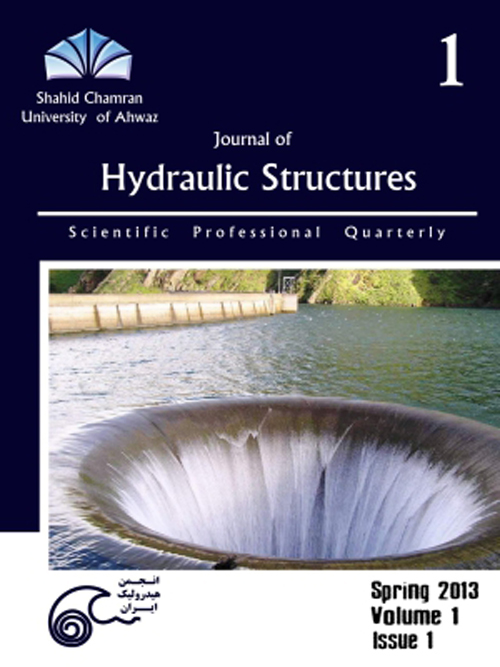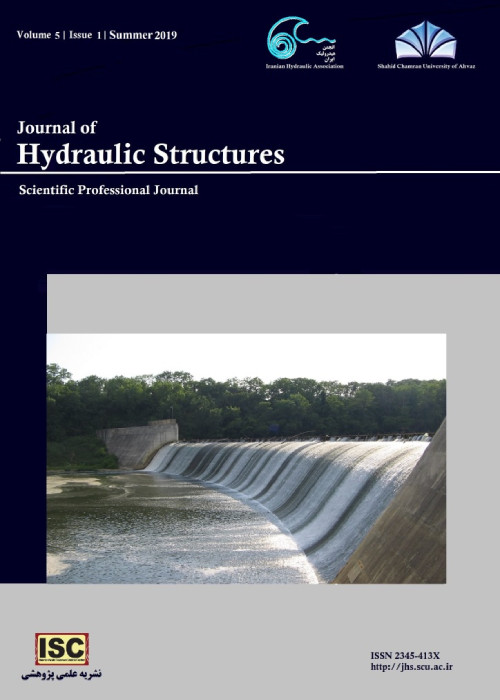فهرست مطالب

Journal of Hydraulic Structures
Volume:2 Issue: 1, Summer 2016
- تاریخ انتشار: 1396/01/15
- تعداد عناوین: 6
-
-
Pages 1-11River confluence is a common feature of most irrigation and drainage channels and river systems, where tributary conflicts the main channel. In these section, rapid changes in velocity and discharge, sediment distribution and flow turbulent result in a deep confluence scour, a bar point in the separation zone at downstream of junction corner and finally vortex flow. Thus, the main goal of this study is to conduct a series of experimental tests to investigate the required size of rocks to control the scour hole. The results show that for a constant ratio discharge, Qr, the size of riprap in the incipient motion increases with decreasing in tailwarer depth. In other words, for any rock size the tailwater depth required for incipient motion increases with increasing the ratio of discharge, Qr. For each constant ratio discharge, or, the size of riprap in the incipient motion increases with increasing in tailwater velocity, Vt. Finally, some equations are presented for predicting the size of rocks and the proposed equations has been compared with existing ones.Keywords: River Confluence, Riprap, Scour hole, Junctions
-
Pages 12-26Generally, the evaluation and assessment of the critical condition of rill formation are useful for a better understanding of soil erosion processes. The inherence characteristics of soils, which have much dynamic variations on the hillslopes and are affected by rill formation, are the soil critical shear stress and soil erodibility factors. This study aims to assess experimental rill incision thresholds, the determined soil critical shear and soil erodibility factors on marl formation based on precipitation characteristics and different slope gradients on sensitive marl soil. The results showed that the rainfall intensity and slope steepness factors separately and together can significantly affect the distance from the point of rill initiation; runoff and rill start time and soil loss values. Rainfall intensity showed more importance than the slope gradient in the point of rill formation. There is a significant relationship between rainfall intensity and slope gradient with rill incision point, time of runoff start and rill start and soil loss. The point of rills formation (slope length) decreases with an increase in slope gradient and rainfall intensity. Finally, the results revealed that the values of soil erodibility factor (Kr) and critical shear stress of marl soil are 0.0015s m-1 and 0.267N m-2, respectively.Keywords: Critical shear stress, soil erosion rate, rainfall intensity, slope gradient, marl
-
Pages 27-33A dam spillway is a hydraulic structure that appropriately and safely diverts the outflow to downstream, so that the dam stability and passing of flood flows can be guaranteed. Compared to straight crest spillway, an Ogee spillway with curvature in plan in a fixed-width can pass more flow. Therefore under the low hydraulic heads and the need for a smaller place in plane, they are considered as an economical structure so that their application from several aspects are under developed. An experimental model of the Garmi-Chay Miane dam spillway was made in 1:50 scale. The water head over spillway crest was measured in the eight discharges values and consequently the efficiency of spillway were determined. For Q/Qd ranging from 0.63-1.13, discharge coefficient had ascendant trend with acceptable agreement against the diagram of USBR, while for Q/Qd between 1.13-1.51, due to the submergence of spillway, the discharge coefficient decreased.Keywords: Convergent lateral walls, Curvature in the plan, Discharge coefficient, Ogee Spillway, Physical modeling
-
Pages 34-47This research was conducted to find a reliable technique to shape an abrupt contraction for minimizing the energy loss. The method may find broader applications in design of variety of transitional cross-sections in hydraulic structures. The streamlines in a 2-D contraction were calculated through solving the potential flow equations in rectangular and curvilinear coordinates. The natural cubic spline equations were applied to approximate the shape of streamlines. The streamlines close to the solid boundary, usually those that represent 5 and 95 percent of the discharge, were repeatedly mapped onto the solid boundary in a trial and error procedure until a negligible difference between two consecutive shapes was achieved. This procedure was applied through a code developed in C, namely Streamlining Program Code or SPC. The initial and final shapes were used to validate SPC by the help of a robust CFD software, OpenFOAM. In a 2-D contraction with contraction ratio of 5, entrance velocity of 1 m/s and outlet pressure of atmosphere (P = 0 pa), the maximum spatial difference between the stream lines found by the code and OpenFOAM was limited to 2.74% that occurred in the entrance of the contraction. Finally, according to the validation, the streamlining technique and the code could successfully applied to shape optimization of hydraulic structures.Keywords: hydraulic design, numerical technique, streamlining, grid generator, verification, OpenFOAM
-
Pages 48-57This paper introduces a methodology for soil slope stability analysis based on optimization, limit equilibrium principles and method of slices. In this study, the slope stability analysis problem is transformed into a constrained nonlinear optimization problem. To solve that, a Self-Adaptive Genetic Algorithm (GA) is utilized. In this study, the slope stability safety factors are the objective functions, slip surface parameters are the decision variables and, the equilibrium equations are the problem constraints. The proposed model satisfies all conditions of the equilibrium completely. It is also applicable to problems with different soil layers, variable soil properties and including pore water pressure. The model is applied against a benchmark example and the results are compared with previous studies. Accordingly, it is found computationally efficient and reliable.Keywords: Slope stability analysis, self, adaptive GA, Method of slices, Equilibrium analysis, Safety factor
-
Pages 58-70The economic and environmental losses due to serious leakage in the urban water supply network have increased the effort to control the water leakage. However, current methods for leakage estimation are inaccurate leading to the development of ineffective leakage controls. Therefore, this study proposes a method based on the blind source separation theory (BSS) to calculate the leakage of water supply network. The method uses fast independent component analysis (FastICA) algorithm to separate flow signal of laboratory and practical measuring area, adopts trend similarity to solve the uncertainty of separation sequence to get hourly change curve of user usage and physical leakage, and embeds the leakage model into amplitude optimization model to solve amplitude uncertainty to obtain physical leakage value. The study found that the estimation of leakage level using the blind source separation is reasonably accurate and facilitates the identification of the subsequent reduction in water leakage. This can provide scientific evidence for leakage reduction and the investment of pressure relief devices in the next stage.Keywords: blind source separation theory (BSS), fast independent component analysis (FastICA), leakage simulation, water consumption, water supply network (WSN), water leakage


